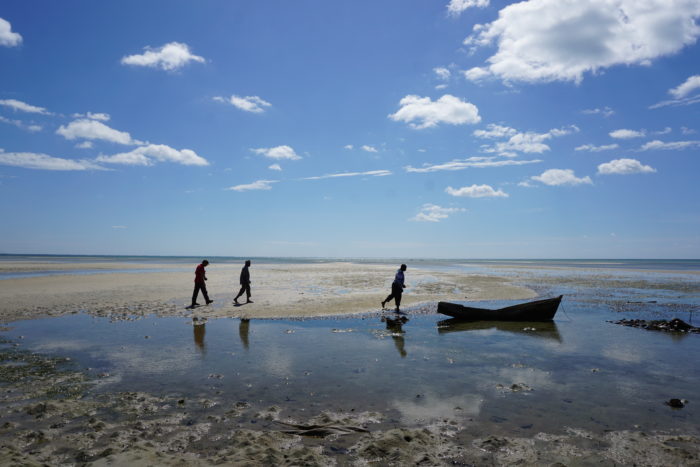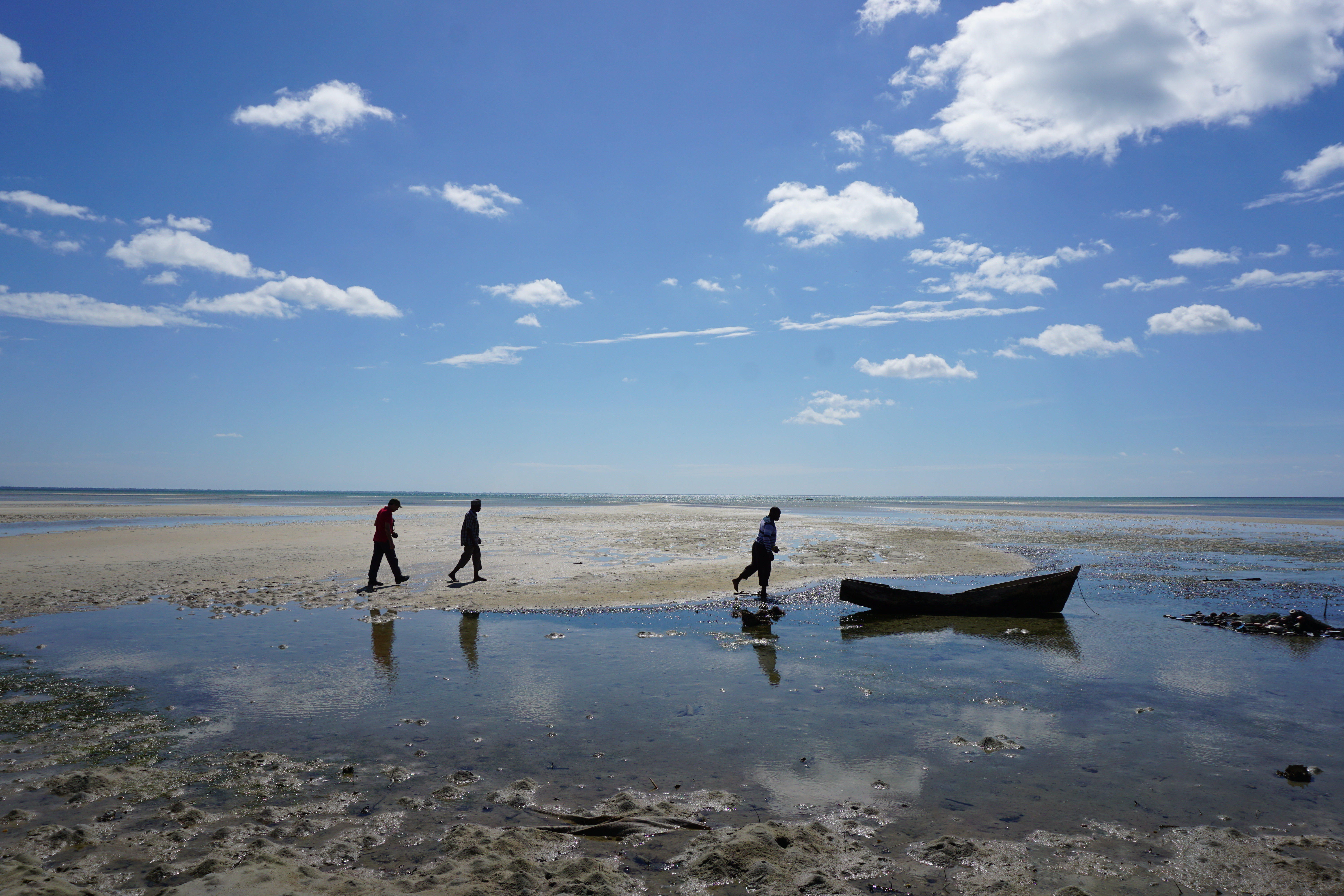This case study was written Kate DeAngelis (Friends of the Earth U.S.), Ilham Rawoot, Anabela Lemos, Daniel Ribeiro (JA!/Friends of the Earth Mozambique), and Dipti Bhatnagar (Friends of the Earth International) for our latest bank report card, Banking on Climate Change: Fossil Fuel Finance Report Card 2019.
Ever since gas was found in the Rovuma Basin off the coast of northern Mozambique in 2010, the communities and environment of Cabo Delgado province have borne the brunt of corporations rushing in to grab their resources.1 Anadarko, ExxonMobil, and Eni — financed by China, France, Italy, South Korea, and other governments, as well as many private banks (listed below) — are key companies involved in extracting and processing the gas.2
The projects are still in the exploration phase, but already thousands of people are being forcibly relocated.3 Anadarko and its partner companies are also proposing to build the country’s first LNG export facility on 17,000 acres on the coast — with the capacity to export nearly 23 million metric tons of LNG per year.4 With their farmland and fishing grounds being taken by multinational corporations, entire communities will lose their homes, land, and livelihoods.5 Locals will receive very few jobs, and an influx of workers from other countries and other parts of Mozambique will likely bring an increase in diseases, including sexually transmitted infections, and place a strain on already limited health-care and education resources.6

The climate impact will be significant as the production, transport, liquefaction, shipping, re-gasification, and power plant combustion of LNG is highly energy-intensive, and thus carbon-intensive; the upstream greenhouse gas emissions from LNG are almost double the greenhouse gas emissions of conventional natural gas.7The carbon emissions from the onshore and offshore projects will increase Mozambique’s total emissions by at least 8 percent.8
The environmental impact of LNG development in this region is massive. Not only will it destroy fishing grounds, but it also threatens the Quirimbas National Park, a UNESCO biosphere reserve that includes areas of pristine coral reefs, mangroves, and seagrass beds.9 Dredging, waste disposal, and construction will devastate ecosystems of endangered plant and animal species.10
Dissent is met with threats from the government and private security, with police sometimes appearing in order to stop meetings. The “consultation process” is farcical, as communities cannot speak out in the presence of leaders, many of whom have relationships with the gas industry or government, for fear of threats or difficulty with any compensation that may have been promised.11
If these are the impacts of the exploration phase, one shudders to think what will happen when companies actually start operating.
Who’s Banking LNG in Mozambique?
| Coral South LNG
Floating LNG vessel offshore of Mozambique |
Mozambique LNG
Offshore LNG production and onshore LNG export terminal |
| Lead companies: Eni, ExxonMobil, China National Petroleum Corporation | Lead company: Anadarko |
| Finance status: A $4.8 billion project finance package was signed in May 2017. 12 Other financial institutions, such as the US Export-Import Bank, are still considering support.13 | Finance status: Anadarko is hoping to make a final investment decision on its $15 billion Mozambique LNG project in the first half of 2019.14 |
Banks:15
|
Banks: The banks that financed Coral South LNG — and their peers around the world — can still make the right choice: stay away from this destructive project. |
- Alan Petzet, “Special Report: Explorers Directing Efforts at Frontier, Underexplored, Nonproducing Basins,” Oil & Gas Journal, 4 April 2011.
- Priscila Azevedo-Rocha, “Mozambique’s Coral South Operators Sign USD 8bn LNG Project Financing; All Lenders Revealed,” Debtwire, 6 June 2017; “ExxonMobil Completes LNG Acquisition in Mozambique Area 4,” ExxonMobil, 13 December 2017; “Mozambique and Shell Sign MoU for Domestic Use of the Rovuma Basin Gas, Oil Review Africa, 22 June 2017.
- Kate DeAngelis, “Report From the Field: Perspectives and Experiences of Mozambican Communities and Civil Society on Liquefied Natural Gas Exploitation,” Friends of the Earth, 14 September 2016.
- Scott DiSavino, “UPDATE 2-Anadarko Expects Final Decision on Mozambique LNG Export Project in 2019,” Reuters, 27 June 2018; “The Project,” Mozambique LNG, accessed January 2019; Maggie Kuang, “LNG Supply & Demand” dataset, Bloomberg Finance L.P., 12 September 2018. (available to Bloomberg New Energy Finance subscribers).
- Kate DeAngelis, “Report From the Field: Perspectives and Experiences of Mozambican Communities and Civil Society on Liquefied Natural Gas Exploitation,” Friends of the Earth, 14 September 2016; Kate DeAngelis, Dipti Bhatnagar, and Sarah Uhlemann, Letter to Fred Hochberg and James Mahoney, Export-Import Bank of the United States, 15 March 2016.
-
The initial environmental impact assessment for the export facility found that local populations have low levels of education and formal work experience. “Chapter 9: Socio-Economic and Community Health Baseline.” In “Environmental Impact Assessment (EIA) Report for the Liquefied Natural Gas Project in Cabo Delgado,” Impacto and ERM, September 2014, pp. 4–5. The subsequent environmental impact study found high levels of illiteracy and reported on the total number of jobs that would be created. Consultec – Consultores Associados, Lda., “Environmental Impact Assessment Process for the Floating Liquefied Natural Gas Project: Environmental Impact Study Final Report,” 2015, pp. 68, 179, 253–54; See, e.g., John Eligon, “An Oil Town Where Men Are Many, and Women Are Hounded,” The New York Times, 13 January 2013.
- Timothy J. Skone, P.E., “Role of Alternative Energy Sources: Natural Gas Technology Assessment,” National Energy Technology Laboratory Office of Strategic Energy Analysis and Planning, U.S. Department of Energy, 30 June 2012; Anthony Zammerilli et al., “Environmental Impacts of Unconventional Natural Gas Development and Production,” National Energy Technology Laboratory, U.S. Department of Energy, 29 May 2014.
- It has been estimated that Area 1 will result in 5.2 million metric tons of CO2 per year and Area 4 will result in 0.1 million metric tons; both of these are likely underestimates. Mozambique’s total emissions were 68.8 million metric tons in 2013. Hannah Furfaro, “Potential Export-Import Bank Deals Pose Grave Environmental Threat, Experts Say,” The Guardian, 7 December 2016; Consultec – Consultores Associados, Lda., “Environmental Impact Assessment Process for the Floating Liquefied Natural Gas Project: Environmental Impact Study Final Report,” 2015, p. 18; Kate DeAngelis, Dipti Bhatnagar, and Sarah Uhlemann, Letter to Fred Hochberg and James Mahoney, Export-Import Bank of the United States, 15 March 2016; “Greenhouse Gas Emissions in Mozambique,” USAID, May 2017.
- “Mozambique Joins World Network of Biosphere Reserves,” UNESCO, 25 July 2018.
- Anabela Lemos, Kate DeAngelis, et al., Letter to Miguel Clüsener-Godt and Didier Babin, 30 October 2018.
- As told to the authors by local community members.
- Bloomberg Finance L.P., accessed January 2019.
- “Liquefied Natural Gas/Mozambique,” Export-Import Bank of the United States, 29 November 2018.
- Marissa Luck, “Anadarko Inks Deals With Tokyo Gas, Shell for Mozambique LNG,” Houston Chronicle, 5 February 2019.
- Bloomberg Finance L.P., accessed January 2019.
